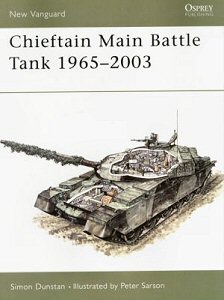

 Chieftain
Main Battle Tank 1965-2003
Chieftain
Main Battle Tank 1965-2003
by Simon Dunstan, illustrated by Peter Sarson
New Vanguard No 80
Osprey Publishing, Elms Court, Chapel Way, Botley, Oxford OX2 9LP
ISBN 1-84176-719-0
48 pages, soft cover
Review by Peter Brown
So, what went wrong? In a word, the engine. A special multi-fuel engine was developed following plans laid down in 1957 for NATO tanks to be able to run on any available fuel from normal petrol and diesel through aviation spirit and household heating fuel. In the event, only Chieftain’s L60 was to be produced to meet this requirement, with the Americans and Germans going for diesels. It is doubly ironic that Chieftain was to run on diesel throughout its life. Its big chance for export when it was trialled by Israel came to nothing though some were sold to Kuwait, Oman and Iran while the improved version with new engine also sold to Jordan as Khalid.
The full story of Chieftain’s development from the early Universal Tank concepts just after WW2 to its introduction into service in the mid-1960s is followed, then the development of the tank from the original Mark 1 through to the final British Mark 11, with all the various upgrades and changes introduced along the way which makes following Sherman and Centurion marks look easy in comparison. While production tanks looks similar, new guns, sights, NBC equipment and improved engines were introduced giving new marks and more variations retrofits. Some like the Mark 4 were rare while the Mark 5 was the basic standard version developed from the Mark 3/3 and it existed as 5/L, 5/1, 5/2 (and 5/2K for export), 5/3P, 5/3 and finally 5/4 which was then converted to Mark 9 standard and from there to Mark 10 with Stillbrew (along with Marks 6/4, 7/4 and 8/4) and Mark 11 with TOGS. Refer to the book for explanations of these if you do not know what they mean!
All the various programmes, Totem Pole, Dark Morn etc to upgrade the tank, fitting Clansman radios and the parallel engine developments such as Sundance with the many marks of engine are also covered. Development of the special purpose vehicles, basic Armoured Recovery Vehicle and improved Armoured Repair and Recovery Vehicle, Armoured Vehicle Launched Bridge and Armoured Vehicle Royal Engineers are also followed.
One area which might have been better covered, assuming information was available, would have been the use of the Chieftain in action. There are only a few details on its use in Iran and a little more on the Kuwaiti tanks which were used in 1991.
As usual with Osprey there are several black and white photos and as usual with Simon Dunstan the captions are mostly long and informative, adding to what is given in the well-written text. Colour plates show the Chieftain in typical service colours with details of users and markings, including tanks in training in Canada in the sand/green scheme used there, plain green and black training and competing with NATO in Europe, the unusual checkerboard scheme developed for vehicles in Berlin, sand yellow AVLB and AVRE on Operation Granby plus a Kuwaiti Martyr’s Brigade tank, the last Chieftain to fire its gun on the ranges in British Army service and of course the cutaway.
Lots of detail here, though I for one would still like to see someone like Concord produce a photo study of the Chieftain. While having the various changes described and listed is good, pictures showing them would be even better. Still, this is a good source for Chieftain fans, old and new.
Page Created 30 October 2003